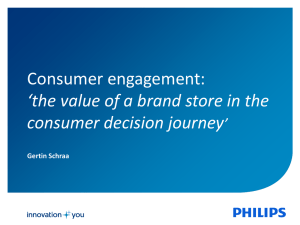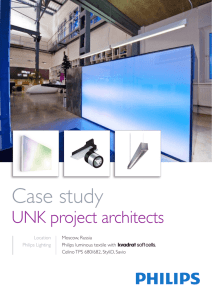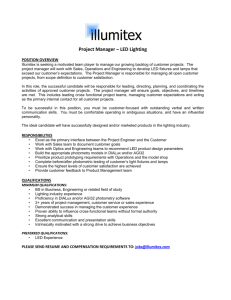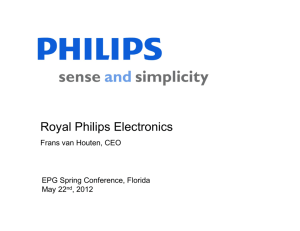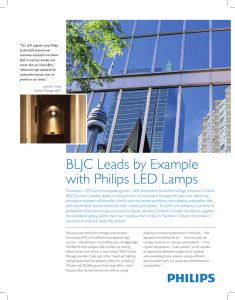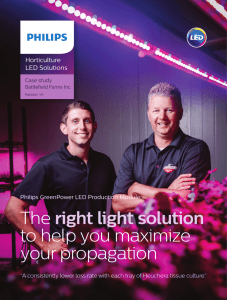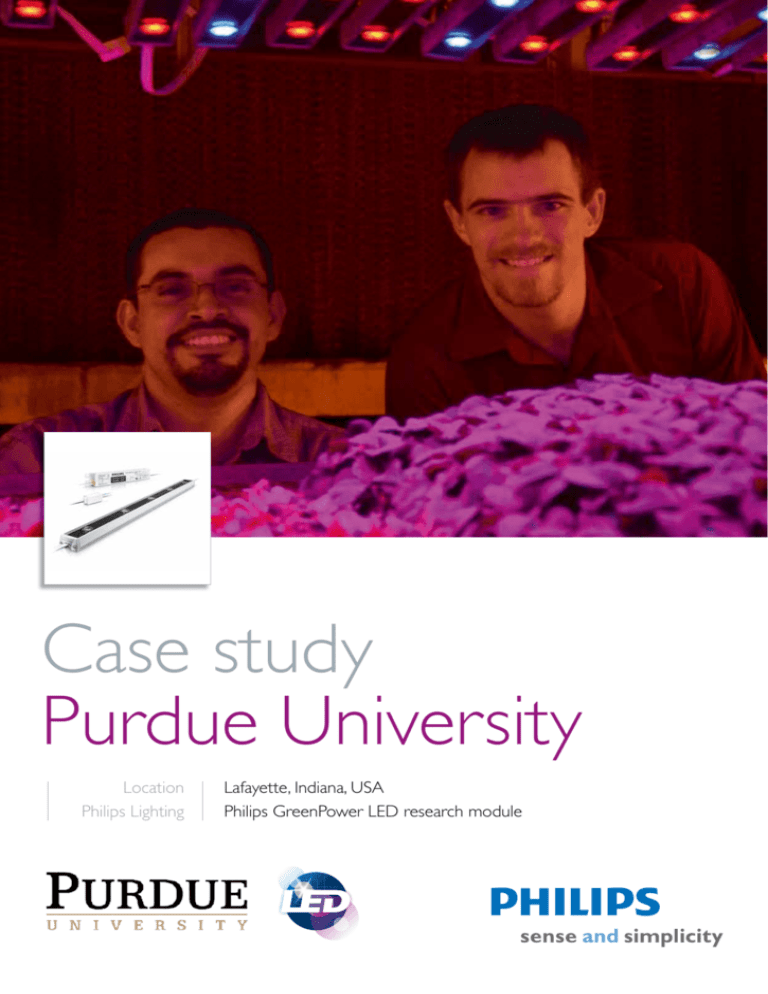
Case study
Purdue University
Location
Philips Lighting
Lafayette, Indiana, USA
Philips GreenPower LED research module
“With LED lighting technologies, we are able to provide
light that plants can utilize for photosynthesis and
potentially save on energy”
Dr. Roberto Lopez, associate professor of horticulture
Christopher Currey, Ph.D. student
Wesley Randall, M.S. student
Background
The challenge
The seed-propagated bedding plant project is supported by
Philips and four-year USDA project is in collaboration with
commercial growers, as well as by other research institutes
such as Rutgers University, the University of Arizona,
Michigan State University, and the Orbital Technologies Corp.
‘Our research will enable specialty-crop growers to
transition from HPS lamps to the much more efficient
LED technologies,’ says Cary Mitchell, professor of
horticulture and project director of the USDA study. ‘We
will do this by working with industry to test and refine
implementation strategies that will significantly reduce
energy-related costs, maintain or increase production
quality, and reduce negative environmental impacts.
By developing a strong best-practice process for LED
implementation, while performing a rigorous economic
In 2010, the Department of Horticulture at Purdue
University received a four-year grant from the US
Department of Agriculture.The grant is to help fund
research regarding how LED technologies could be used
as supplemental, photoperiodic, and photomorphogenic
lighting in commercial greenhouses that grow bedding plants
(young and finish) and vegetables (transplants and high-wire).
Currently, this $6-billion-a-year industry uses High-Pressure
Sodium (HPS) lamps to supplement daylight and incandescent
bulbs for photoperiodic lighting at various stages of the
growing process. However, much of the energy used to
power HPS lamps is wasted in producing heat – only 30% of
the energy is converted to photosynthetically active radiation
or PAR that the plant can utilize for photosynthesis.
LED technology is an ideal candidate to potentially replace
HPS lamps in commercial greenhouses. LED lamps are
energy-efficient, long-lasting, and can be placed close to
seedlings or mature plants. However, each plant species
may have its own optimum mix of light wavelengths.
Hence, the challenge was to find the correct Blue-Red
lighting ratio during seed propagation of the ten most
popular bedding plants sold in the US – plants such as
petunia, pansy, geranium, and marigold.
This means: reduced cultivation time, better-controlled cultivation
processes, better plant quality and uniformity, continuous delivery
all year round, more efficient use of space
Facts
Grower
Purdue University
Sector
University research for bedding and pot plant grower
Crop
Ten most popular bedding and potted plants in the USA
Location
Lafayette, Indiana, USA
Solution
Philips GreenPower LED research module
Philips LED Horti Partner
Hort Americas, LLC
Results
Applied research and technology transfer
and marketing analysis, our research will encourage the
economic sustainability and growth of specialty crops in
the United States.’
The solution
One of the major advantages of LED light sources is that
they are dimmable and available in various colors, including
deep red, blue, and far red. By testing a variety of red/blue
LED lighting combinations, the project has identified the best
ratio for ten plant species. Other significant observations
included: Higher plug quality than those produced under
HPS lamps; A combination of Red and blue LEDs seem to
be effective in producing compact, fully-rooted seedlings
of some species; LEDs resulted in cuttings with growth
comparable to those grown under HPS; Photosynthesis of
cuttings was not significantly affected by supplemental light
source. In addition, because Philips LED solutions are based
on many years of experience with the horticultural world,
Philips could offer specific ‘light recipes’ that can be tailored
to different plant species.
Benefits
Although the four-year project started in 2010 and is
currently ongoing, the energy-saving benefits are clear: to
enable an HPS lamp to provide the correct amount of light
in the wavelengths required, it needs 6.42 kWh per day.
For the same amount of light in the correct wavelengths,
an LED lamp needs only 2.83 kWh per day – a saving of
56%! In addition, future research at Purdue will determine
if it is possible to propagate bedding plants in multilayer
“One of the advantages of LED light
sources is that they are dimmable and
available in various colors.”
environments without any daylight.This could mean: reduced
cultivation time, better-controlled cultivation processes,
better plant quality and uniformity, continuous delivery all
year round, and more efficient use of space.
© 2013 Koninklijke Philips Electronics N.V.
All rights reserved. Reproduction in whole or in part is prohibited without the prior written consent of the copyright owner. The information
presented in this document does not form part of any quotation or contract, is believed to be accurate and reliable and may be changed without
notice. No liability will be accepted by the publisher for any consequence of its use. Publication there of does not convey nor imply any license
under patent- or other industrial or intellectual property rights.
01/2013
Document order number: 3222 635 XXXXX
www.philips.com/horti


